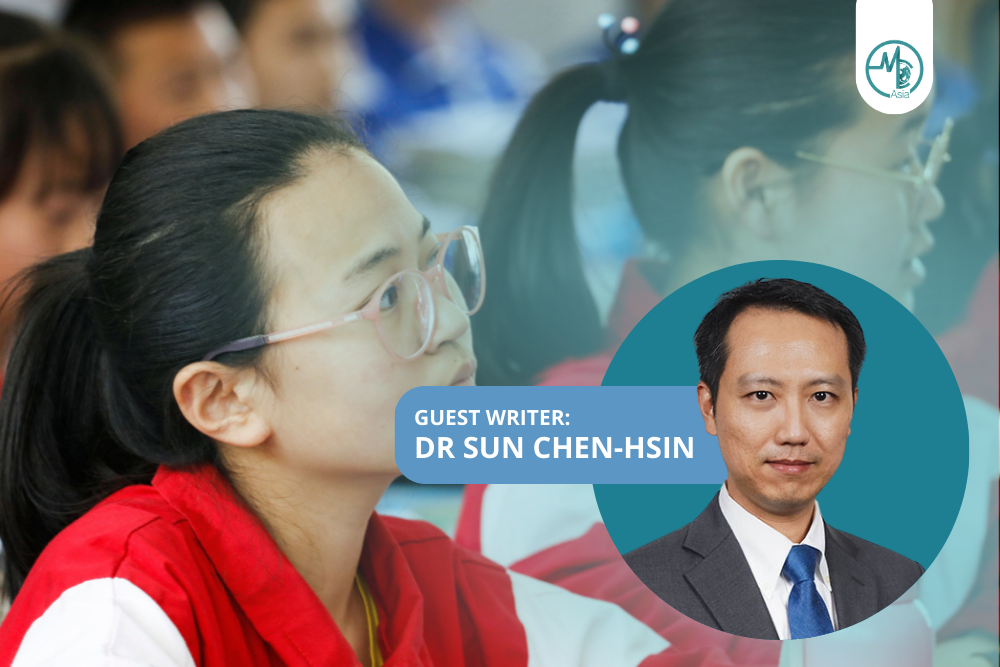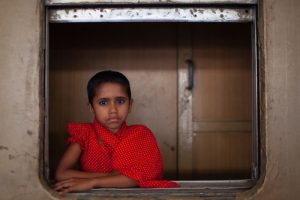Singapore has one of the highest prevalence of myopia in the world among children, with 65 per cent of our children being myopic by Primary 6.
Refractive error is the leading cause of blurry vision in school-going children in Singapore [1]. Blurry vision is typically caused by myopia (short-sightedness), hyperopia (long-sightedness) or astigmatism (blurred distance and near vision) [2, 3], with myopia being the most common eye condition affecting children in Singapore today (4).
According to the Strabismus, Amblyopia, and Refractive Error in Young Singaporean Children (STARS) study, blurry vision caused by myopia is seen in 11% of children aged six to 72 months [4]. Statistics from the Singapore National Eye Centre further reveal that 10% of Singaporean children develop myopia by age five, increasing to 60% and 80% by ages 12 and 18, respectively [5].
When blurry vision develops at a young age, pre-verbal children who have not developed their language skills can find it challenging to communicate their vision problems to parents. Most children may not even understand blurry vision and assume it is normal [6], delaying diagnosis and treatment.
If not intervened early, myopia can progress to high myopia. The Singapore Ministry of Health predicts that by 2050, up to 90% of Singaporean adults over 18 will be myopic, with 15% to 25% at risk of high myopia, which puts them at risk of sight-threatening conditions in later life [7]. High myopia, defined as near-sightedness of more than -6.00 diopters or an eyeball length longer 26mm, increases one’s risk of sight-threatening vision disorders. These include early cataracts, glaucoma, retinal detachment, which causes blindness, and macular degeneration where there is no cure [8].
How To Detect Blurry Vision In Children
Because children often cannot articulate problems with their vision, parents, teachers, and caregivers must be proactive in looking out for signs and symptoms of myopia in young children. For example, pre-verbal children between the ages of three and four often squint when trying to see distant objects or move closer to objects they want to focus on. Tilting the head to see an object may indicate astigmatism.
For school-going children aged five and above, teachers play a crucial role in noticing if he or she has difficulty seeing. Signs such as needing to sit closer to the whiteboard, frequent complaints of headaches, reduced participation in class when seated at the back of the room, and increased participation when seated at the front could indicate the child is suffering from vision problems.
Fortunately, in Singapore, there are Childhood Developmental Screenings for citizens and permanent residents to assess blurry vision in children. General practitioners (GPs) in polyclinics assess young children aged one to four to determine if they exhibit symptoms of vision problems such as poor eye contact or uncoordinated eye movements. When children turn four, they undergo a visual acuity test with the Snellen chart, conducted annually under the Health Promotion Board (HPB)’s Youth Preventive Health Services in primary schools.
Generally, eye care professionals (ECPs) will see children with a visual acuity of 6/12 or worse. Ophthalmologists handle those seven and below, while optometrists see older children.
Treatment Options For Myopia And Myopia Progression
Children can experience different types of refractive errors simultaneously, not just myopia. This is why it is crucial to determine the true cause or causes of vision problems.
Regular ‘single vision’ optical lenses can clear blurry vision caused by myopia, hyperopia, and astigmatism. Most children with myopia opt for this treatment. Although these lenses enable children to see clearly, they do not prevent further progression of myopia due to progressive elongation of the eyeball. The lenses must be updated periodically as the child’s myopia degree increases.
To control myopia progression, we must control its root cause, which is the elongation of the eyeball. Myopia progression can be managed using lifestyle modifications, pharmacological treatments or optical interventions, or a combination of all three.
Generally, I find that lifestyle modifications, when coupled with evidence-based treatments, yield the best results. I recommend spending more time outdoors and reducing near work as these have been shown to prevent nearsightedness in children.
In one Australian study, students who spent more time doing near work and less time outdoors had a higher risk of myopia than children who spent less time on near work and more time outdoors [9]. Other studies showed that although Australian children read more books, a form of near work, per week than their Singaporean counterparts, the prevalence of myopia in Singaporean children (29.1%) was significantly higher compared to Australian children (3.3%) as Australian children spend at least three hours outdoors per week, compared to Singaporean children who only spend about 13.75 minutes outdoors per week [10].
Pharmacological treatments, like atropine eye drops, effectively control myopia progression. This works even in patients on the lowest dose (0.01%) [11].
Intervention Options
Optical interventions include myopia management contact lenses and spectacles. These novel lenses differ from traditional lenses as they create rings of ‘peripheral defocus’ that bring the focus of light rays forward to match the natural curvature of eyeballs.
Scientists have hypothesised that bringing focus in the peripheral retina to the front of the retina can prevent myopia progression. This has been proven in research including studies of myopia management glasses in Hong Kong which showed children who wore single-vision lenses experienced an increase in myopia of 100 degrees, while those using myopia control lenses only regressed by 40 degrees over a two-year period [12]. In other research involving a multicentre study of dual-focus contact lenses performed in the United Kingdom, Portugal, Canada and Singapore, these lenses have been shown to slow down myopia progression by up to 50% in children aged eight to 17 years [13].
While early intervention is ideal when managing myopia, studies show introducing dual-focus contact lenses at any age have been effective in slowing down or controlling myopia progression [13]. Compared to overnight Orthokeratology (Ortho-k) lenses, daily disposable contact lenses also reduce the risk of eye infection in younger children, who may be unable to care for their lenses without adult assistance. Although Ortho-k lenses are a recognised form of optical intervention for myopia, they carry a higher risk of corneal infection [14].
Dual-focus myopia control contact lenses should be considered for children who are very active or those whose myopia continues to progress despite using other interventions. They are also ideal for anisometropic patients or have myopia in only one eye. This is because it eliminates the risk of double vision that can arise with wearing glasses.
Conclusion
Fortunately, while Singapore’s competitive academic environment plays a significant role in the rising levels of myopia in our children, eye care practitioners are now equipped to detect and diagnose myopia in children as young as two years old and a range of evidence-based treatments to control myopia. Hopefully, with sufficient awareness and proactive action, the myopia epidemic can be curtailed before it becomes critical.
This article is a guest article written by Dr Sun Chen-Hsin. Dr Sun Chen-Hsin is a Consultant Ophthalmologist at the National University Hospital Singapore. In addition to his expertise in managing progressive myopia in children, Dr Sun is also an engineer, with special interests in developing paediatric ophthalmology technologies, including a wearable device that tracks outdoor time and near reading.
References:
[1] Saw, S. M., Tong, L., Chua, W. H., Chia, K. S., Koh, D., Tan, D. T., & Katz, J. (2005). Incidence and progression of myopia in Singaporean school children. Investigative Ophthalmology & Visual Science, 46(1), 51-57. https://iovs.arvojournals.org/article.aspx?articleid=2163491.
[2] Wojciechowski, R. (2011). Nature and nurture: the complex genetics of myopia and refractive error. Clinical Genetics, 79(4), 301-320. https://www.ncbi.nlm.nih.gov/pmc/articles/PMC3058260/.
[3] Read, S. A., Vincent, S. J., & Collins, M. J. (2014). The visual and functional impacts of astigmatism and its clinical management. Ophthalmic and Physiological Optics, 34(3), 267-294. https://onlinelibrary.wiley.com/doi/full/10.1111/opo.12128.
[4] Dirani, M., Chan, Y. H., Gazzard, G., Hornbeak, D. M., Leo, S. W., Selvaraj, P., … & Saw, S. M. (2010). Prevalence of refractive error in Singaporean Chinese children: the strabismus, amblyopia, and refractive error in young Singaporean Children (STARS) study. Investigative Ophthalmology & Visual Science, 51(3), 1348-1355. https://pubmed.ncbi.nlm.nih.gov/19933197/
[5] Myopia (2021). Myopia Research Group. Singapore National Eye Centre, SingHealth. https://www.snec.com.sg/research-innovation/research-groups-platforms/research-groups/myopia. Accessed 1 Aug 2023.
[6] Myopia on the rise (2021, June 16). Singapore National Eye Centre. https://www.snec.com.sg/news/patient-care/myopia-on-the-rise. Accessed 28 Aug 2023.
[7] Ministry of Health, “Speech by Dr Lam Pin Min, Senior Minister of State for Health, At The Opening of the Singapore National Eye Centre’s Myopia Centre, 16 August 2019,” Accessible at: https://www.moh.gov.sg/news-highlights/details/speech-by-dr-lam-pin-min-senior-minister-of-state-for-health-at-the-opening-of-the-singapore-national-eye-centre-s-myopia-centre-16-august-2019. Accessed 1 Aug 2023.
[8] Williams, K., & Hammond, C. (2019). High myopia and its risks. Community Eye Health, 32(105), 5. https://www.ncbi.nlm.nih.gov/pmc/articles/PMC6688422/.
[9] Rose, K. A., Morgan, I. G., Ip, J., Kifley, A., Huynh, S., Smith, W., & Mitchell, P. (2008). Outdoor activity reduces the prevalence of myopia in children. Ophthalmology, 115(8), 1279-1285. https://www.sciencedirect.com/science/article/abs/pii/S0161642007013644.
[10] Rose, K. A., Morgan, I. G., Smith, W., Burlutsky, G., Mitchell, P., & Saw, S. M. (2008). Myopia, lifestyle, and schooling in students of Chinese ethnicity in Singapore and Sydney. Archives of Ophthalmology, 126(4), 527-530. https://pubmed.ncbi.nlm.nih.gov/18413523/.
[11] Chia, A., Chua, W. H., Cheung, Y. B., Wong, W. L., Lingham, A., Fong, A., & Tan, D. (2012). Atropine for the treatment of childhood myopia: safety and efficacy of 0.5%, 0.1%, and 0.01% doses (Atropine for the Treatment of Myopia 2). Ophthalmology, 119(2), 347-354. https://pubmed.ncbi.nlm.nih.gov/21963266/.
[12] Lam, C. S., Tang, W. C., Lee, P. H., Zhang, H. Y., Qi, H., Hasegawa, K., & To, C. H. (2022). Myopia control effect of defocus incorporated multiple segments (DIMS) spectacle lens in Chinese children: results of a 3-year follow-up study. British Journal of Ophthalmology, 106(8), 1110-1114. https://bjo.bmj.com/content/106/8/1110.
[13] Arumugam, B., Bradley, A., Hammond, D., & Chamberlain, P. (2021). Modelling Age Effects of Myopia Progression for the MiSight 1 day Clinical Trial. Investigative Ophthalmology & Visual Science, 62(8), 2333-2333. https://iovs.arvojournals.org/article.aspx?articleid=2775367.
[14] Bullimore, M. A., & Johnson, L. A. (2020). Overnight orthokeratology. Contact Lens and Anterior Eye, 43(4), 322-332. https://www.sciencedirect.com/science/article/pii/S1367048420300618.
Additonal Notes
* Using measured and modeled data, pooled across ages (8 17), MiSight® 1 day slowed myopia progression by an average of approximately 50%.
+ Children ages 8 to 15 when starting MiSight 1 day treatment experienced a slowing of myopia progression.













